In an effort to reduce the numbers on the mart premises at any one time, the cattle sale at Bandon Mart was moved to Thursday so the focus was solely on the calf sale.
There was around 1,100 on offer. This was a few hundred back on the usual second half of March.
Referring to the number, mart manager Tom McCarthy said: "I can understand that because people are nervous about moving out. We're not under normal times here.

A sign of the times. Farmers are getting used to the new steps introduced to reduce the risk of coronavirus at marts.
"We asked sellers not to leave their vehicles. We're conscious of the risk involved and also conscious of trying to keep the business open for farmers.
"In fairness people are working with us. We're taking the calves, numbering and selling them and farmers are ringing us then later on for their prices.
Export market
"There's exporters exporting away Anguses and there's a few lads there from the North for the good whitehead and Belgian Blue and Simmental."
Regarding the cattle sale on Thursday, Tom said: "So far, farmers will be allowed in to sell their cattle. But the rules are changing day by day and we're just trying to keep the service going the best way we can."

With the cattle sale moved to Thursday, the intake was quiet.
The splitting of the sales has eased the workload on staff. Tom said: "Last Monday, everybody was on edge when the big lockdown started to come. To be fair, the majority of people appreciated it."
The numbers in the calf ring floated around the 30 mark at any one time in an effort to give space between people.
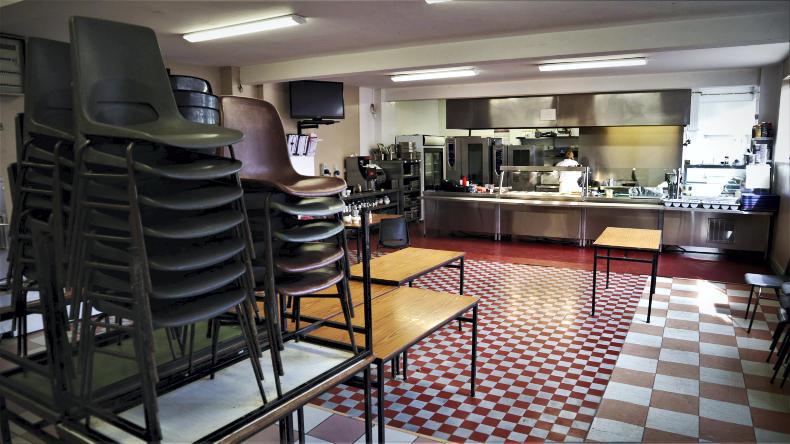
Footfall is reduced in excess of 70% at the mart canteen so a basic take-away service is now in place and seating has been put to one side.
Cork marts had new steps in place this week as Tom describes: "We've strict protocols. What we're doing is permitting the buyers into the ring.
"There's no point filling that up with sellers or people saying they're buyers and they're not. You must register coming in and you get a name tag and then you're allowed into the ring. It's all about traceability and accountability to try and keep the thing going."
Reaction
Derry Scannell dropped his calves into the mart at 6am Monday morning and was after calling in to see his prices. Speaking to the Irish Farmers Journal, he said: "I was happy enough with my prices. They were on the trend of the last couple of weeks. They were marginally up on what I got last week."
He went on to describe what he had to do at the calf drop-off earlier and, while apprehensive, he was glad the facility was still there to take calves off farm at a busy time of year.
"We were met by staff and given a form to fill and we had to drop and go. You'd be nervous, you're depending on what price they're there and you're not there to see what they're making at the ringside.
"But you can’t let the calves at home either or they'll build up so you have to move. We can’t have big numbers here anymore. They're providing a service and hopefully it will continue."
While the nervousness of farmers selling was understandable, especially for those accustomed to seeing their calves sell, a strong trade should go a long way to settle nerves.
Drop in Friesian numbers
There was a noticeable drop in Friesian bull calf numbers and this helped trade for these, with €45 to €101 the going rate for shipping calves. Demand for the stronger-type Friesian calf saw prices from €120 to €160 reached far more often than normal. These topped out at €225. There was a selection of calves available under €45 also, but the floor on these was higher than recent sales.
Moving to beef-crosses, Angus- and Hereford-crosses picked up the shortfall of Friesian calves. Traditional beef-crosses mainly sold in a €150 to €335 price bracket.
Age of the calf and the breed of its dam played a big part in deciding which end of that range the calf sold for. The square calf with more British Friesian blood was at the top end, while the lighter finer-boned calf with a stronger chance of being from a cross-bred herd was at the lower end of the scale.
The spread of prices for Angus and Hereford heifer calves was from €90 to €240. In a smaller sale, there was a higher proportion of continental calves. Bull calves sold for up to €395, while heifers made up to €335.
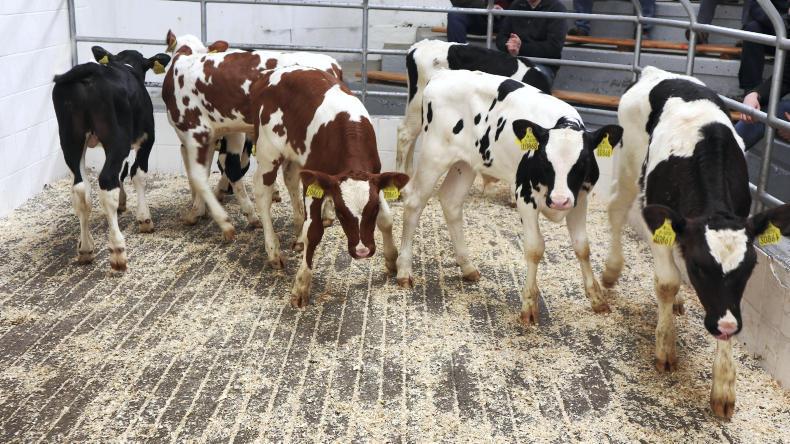
Over five weeks of age, this group of bull calves averaged €95.
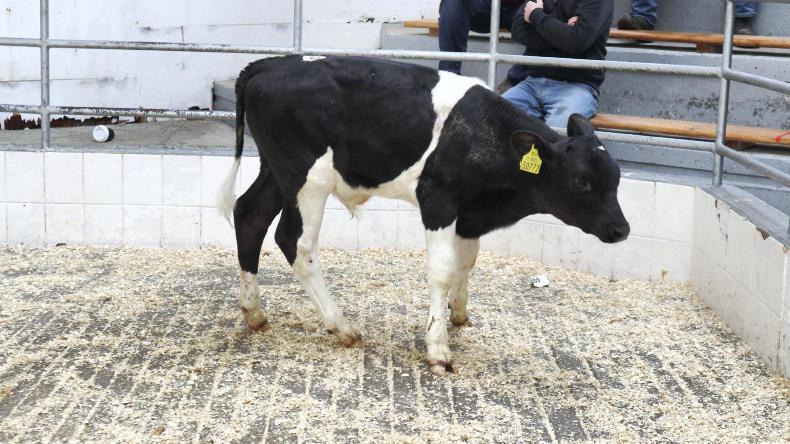
Just over a month old, this bull calf sold for €128.

This month old Angus bull calf sold for €240.
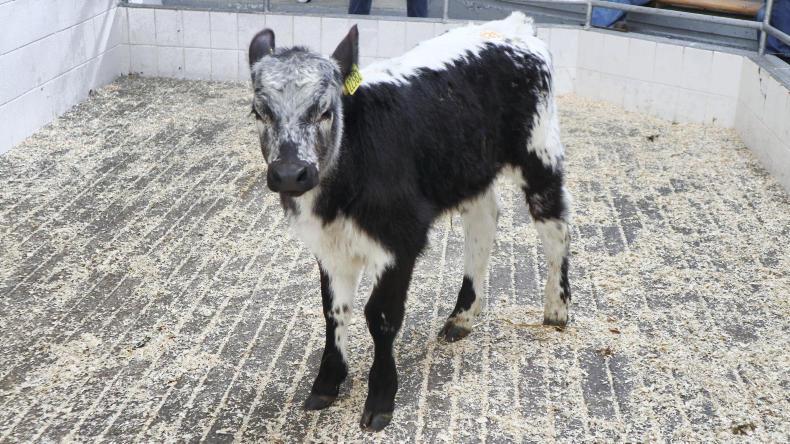
This five week old speckled park bull calf made €220.
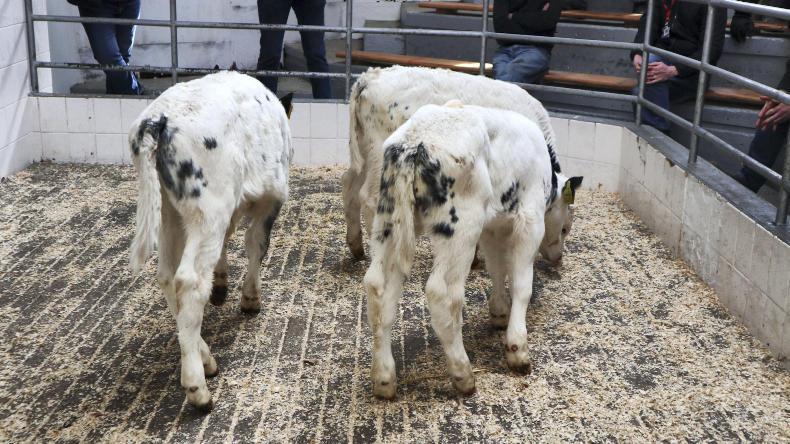
These heifer calves made €202.

This group of bull calves averaged €168.
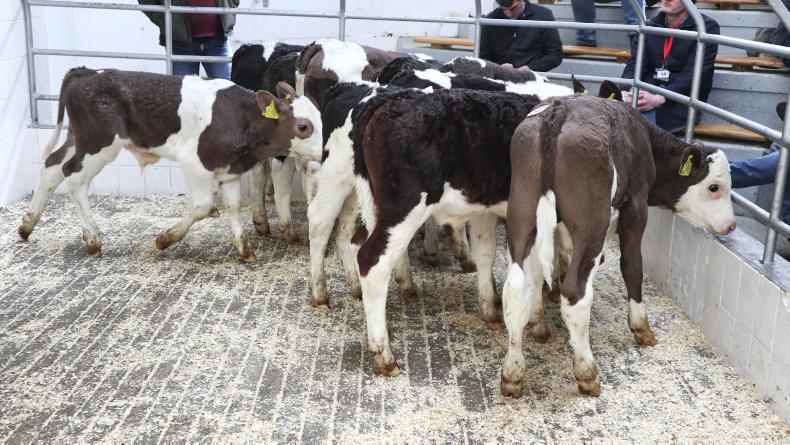
This group of Simmental bull calves went for €315.
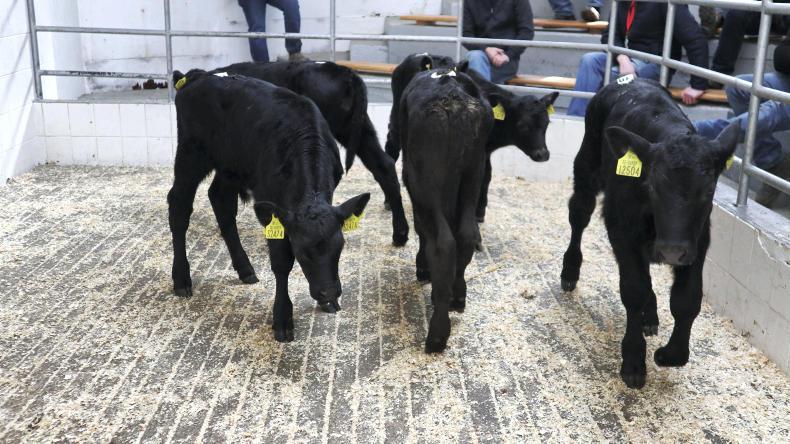
This group of Angus bull calves sold for €160.
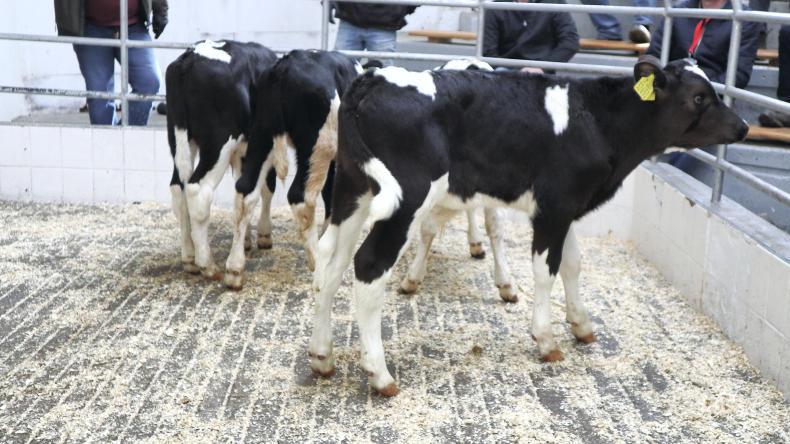
Just short of 5 weeks of age, this group of bull calves sold for €160.
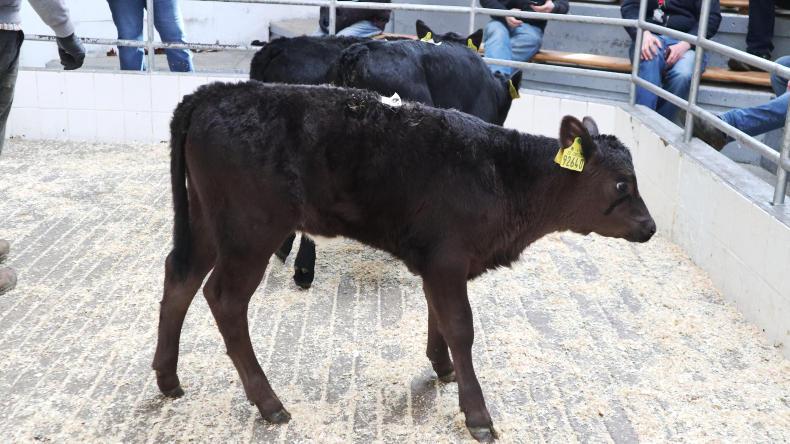
This trio of month old Angus heifer calves sold for €180.
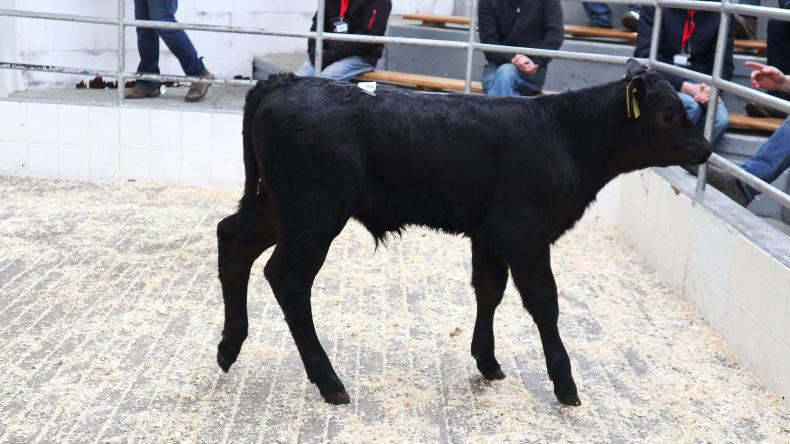
A three week old Angus bull calf he made €255.
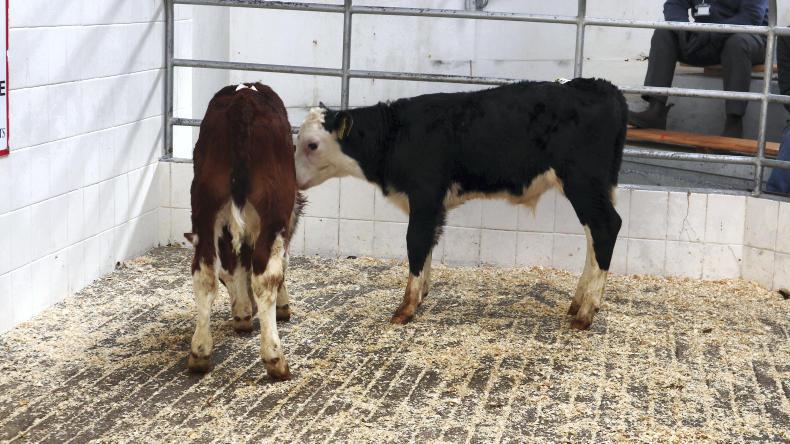
Just short of a month old, these bull calves made €178.
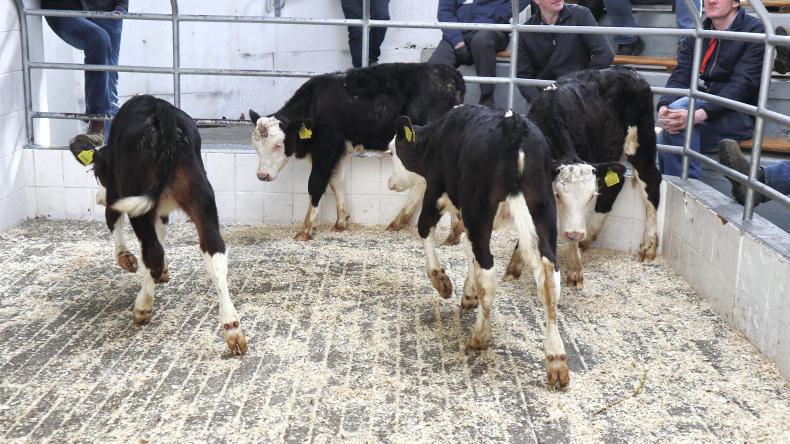
This group of heifers are around the five week old mark and sold for €188.
In an effort to reduce the numbers on the mart premises at any one time, the cattle sale at Bandon Mart was moved to Thursday so the focus was solely on the calf sale.
There was around 1,100 on offer. This was a few hundred back on the usual second half of March.
Referring to the number, mart manager Tom McCarthy said: "I can understand that because people are nervous about moving out. We're not under normal times here.

A sign of the times. Farmers are getting used to the new steps introduced to reduce the risk of coronavirus at marts.
"We asked sellers not to leave their vehicles. We're conscious of the risk involved and also conscious of trying to keep the business open for farmers.
"In fairness people are working with us. We're taking the calves, numbering and selling them and farmers are ringing us then later on for their prices.
Export market
"There's exporters exporting away Anguses and there's a few lads there from the North for the good whitehead and Belgian Blue and Simmental."
Regarding the cattle sale on Thursday, Tom said: "So far, farmers will be allowed in to sell their cattle. But the rules are changing day by day and we're just trying to keep the service going the best way we can."

With the cattle sale moved to Thursday, the intake was quiet.
The splitting of the sales has eased the workload on staff. Tom said: "Last Monday, everybody was on edge when the big lockdown started to come. To be fair, the majority of people appreciated it."
The numbers in the calf ring floated around the 30 mark at any one time in an effort to give space between people.

Footfall is reduced in excess of 70% at the mart canteen so a basic take-away service is now in place and seating has been put to one side.
Cork marts had new steps in place this week as Tom describes: "We've strict protocols. What we're doing is permitting the buyers into the ring.
"There's no point filling that up with sellers or people saying they're buyers and they're not. You must register coming in and you get a name tag and then you're allowed into the ring. It's all about traceability and accountability to try and keep the thing going."
Reaction
Derry Scannell dropped his calves into the mart at 6am Monday morning and was after calling in to see his prices. Speaking to the Irish Farmers Journal, he said: "I was happy enough with my prices. They were on the trend of the last couple of weeks. They were marginally up on what I got last week."
He went on to describe what he had to do at the calf drop-off earlier and, while apprehensive, he was glad the facility was still there to take calves off farm at a busy time of year.
"We were met by staff and given a form to fill and we had to drop and go. You'd be nervous, you're depending on what price they're there and you're not there to see what they're making at the ringside.
"But you can’t let the calves at home either or they'll build up so you have to move. We can’t have big numbers here anymore. They're providing a service and hopefully it will continue."
While the nervousness of farmers selling was understandable, especially for those accustomed to seeing their calves sell, a strong trade should go a long way to settle nerves.
Drop in Friesian numbers
There was a noticeable drop in Friesian bull calf numbers and this helped trade for these, with €45 to €101 the going rate for shipping calves. Demand for the stronger-type Friesian calf saw prices from €120 to €160 reached far more often than normal. These topped out at €225. There was a selection of calves available under €45 also, but the floor on these was higher than recent sales.
Moving to beef-crosses, Angus- and Hereford-crosses picked up the shortfall of Friesian calves. Traditional beef-crosses mainly sold in a €150 to €335 price bracket.
Age of the calf and the breed of its dam played a big part in deciding which end of that range the calf sold for. The square calf with more British Friesian blood was at the top end, while the lighter finer-boned calf with a stronger chance of being from a cross-bred herd was at the lower end of the scale.
The spread of prices for Angus and Hereford heifer calves was from €90 to €240. In a smaller sale, there was a higher proportion of continental calves. Bull calves sold for up to €395, while heifers made up to €335.

Over five weeks of age, this group of bull calves averaged €95.

Just over a month old, this bull calf sold for €128.

This month old Angus bull calf sold for €240.

This five week old speckled park bull calf made €220.

These heifer calves made €202.

This group of bull calves averaged €168.

This group of Simmental bull calves went for €315.

This group of Angus bull calves sold for €160.

Just short of 5 weeks of age, this group of bull calves sold for €160.

This trio of month old Angus heifer calves sold for €180.

A three week old Angus bull calf he made €255.

Just short of a month old, these bull calves made €178.

This group of heifers are around the five week old mark and sold for €188.






















 This is a subscriber-only article
This is a subscriber-only article










SHARING OPTIONS: